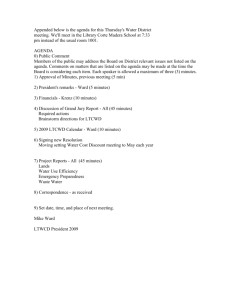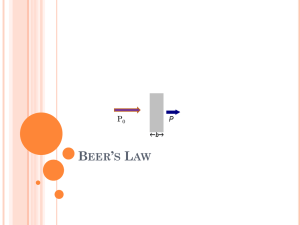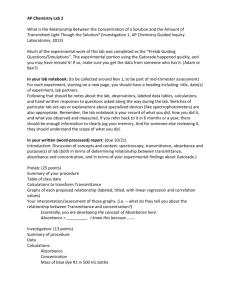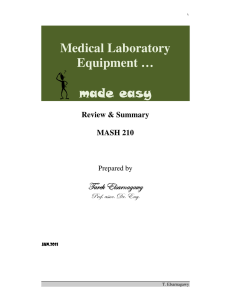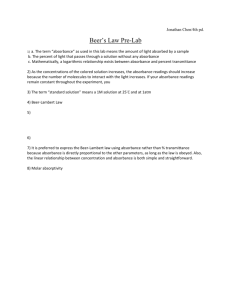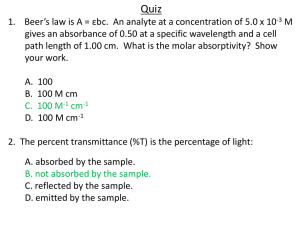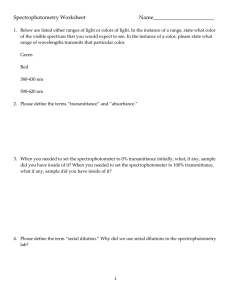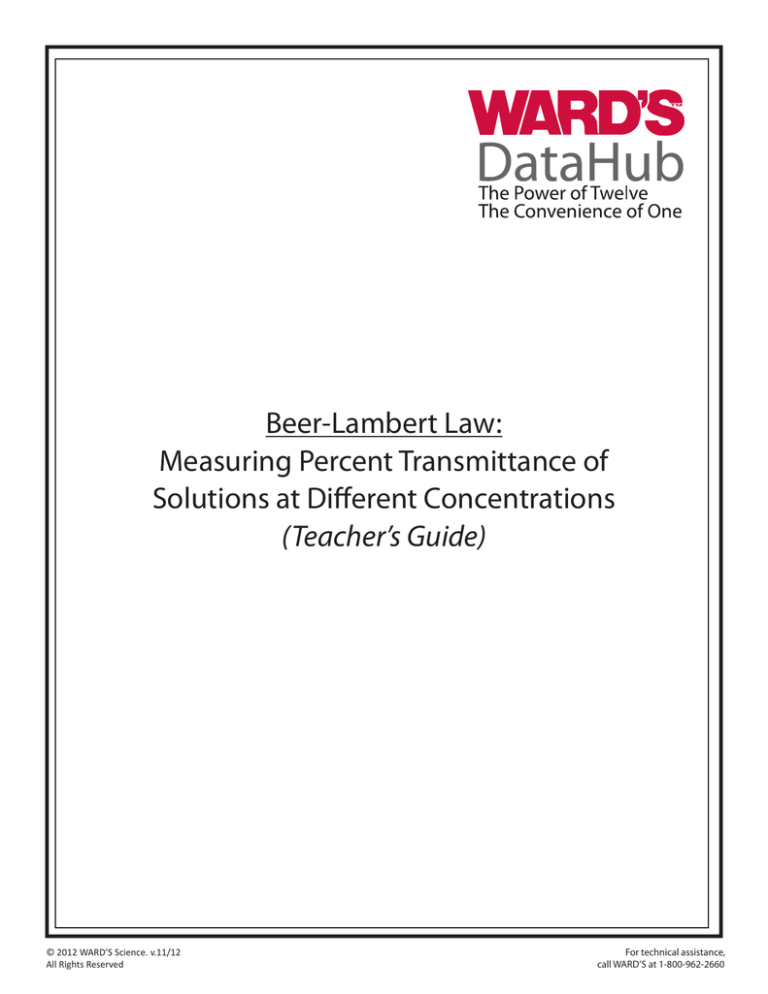
Beer-Lambert Law:
Measuring Percent Transmittance of
Solutions at Different Concentrations
(Teacher’s Guide)
© 2012 WARD’S Science. v.11/12
All Rights Reserved
For technical assistance,
call WARD’S at 1-800-962-2660
OVERVIEW
Students will study the relationship between transmittance, absorbance, and concentration
of one type of solution using the Beer-Lambert law. They will determine the concentration
of an “unknown” sample using mathematical tools for graphical analysis.
MATERIALS NEEDED
Ward’s DataHub
USB connector cable*
Cuvette for the colorimeter
Distilled water
6 - 250 mL beakers
Instant coffee
Paper towel
Wash bottle
Stir Rod
Balance
* – The USB connector cable is not needed if you are using a Bluetooth enabled device.
NUMBER OF USES
This demonstration can be performed repeatedly.
© 2012 WARD’S Science. v.11/12
All Rights Reserved
Teacher’s Guide – Beer-Lambert Law
For technical assistance,
call WARD’S at 1-800-962-2660
FRAMEWORK FOR K-12 SCIENCE EDUCATION © 2012
Asking questions (for science) and defining
problems (for engineering)
Use mathematics and computational thinking
Developing and using models
Constructing explanations (for science) and designing
solutions (for engineering)
Planning and carrying out investigations
Engaging in argument from evidence
Analyzing and interpreting data
Obtaining, evaluating, and communicating information
Patterns
Energy and matter: Flows, cycles, and conservation
Cause and effect:
Mechanism and explanation
Structure and function
Scale, proportion, and quantity
Stability and change
Systems and system models
Discipline
Middle School Standards Covered
High School Standards Covered
MS.PS-SPM: Structure and Properties of Matter
HS.PS-SPM: Structure and Properties of Matter
Core Concepts
Dimension 3
NGSS
Standards
Cross Cutting
Concepts
Dimension 2
Dimension 1
Science and Engineering
Practices
* The Dimension I practices listed below are called out as bold words throughout the activity.
Core Idea Focus
PS1: Matter and Its Interactions
Physical Science
PS1.A: Structure and Properties of Matter
NATIONAL SCIENCE EDUCATION STANDARDS © 2002
Content Standards (K-12)
Systems, order, and organization
Evidence, models, and explanation
Constancy, change, and measurement
Physical Science Standards Middle School
Physical Science Standards High School
Properties and Changes of Properties in Matter
Structure of Atoms
Motions and Forces
Evolution and equilibrium
Transfer of Energy
Form and Function
Structure and Properties of Matter
Chemical Reactions
Motions and Forces
Conservation of Energy and Increase in Disorder
Interactions of Energy and Matter
© 2012 WARD’S Science. v.11/12
All Rights Reserved
Indicates Standards Covered in Activity
Teacher’s Guide – Beer-Lambert Law
For technical assistance,
call WARD’S at 1-800-962-2660
LEARNING OBJECTIVES
Core Objectives (National Standards):
•
Develop the ability to refine ill-defined questions and direct to phenomena that can be
described, explained, or predicted through scientific means.
•
Develop the ability to observe, measure accurately, identify and control variables.
•
Decide what evidence can be used to support or refute a hypothesis.
•
Gather, store, retrieve, and analyze data.
•
Become confident at communicating methods, instructions, observations, and results
with others.
Activity Objectives:
The purpose of this activity is to relate light absorbance and transmittance in solutions
with different concentrations, create a hypothesis and proceed to test it using the Ward’s
DataHub colorimeter sensor.
Time Requirement:
60 - 90 minutes
© 2012 WARD’S Science. v.11/12
All Rights Reserved
Teacher’s Guide – Beer-Lambert Law
For technical assistance,
call WARD’S at 1-800-962-2660
VOCABULARY
Absorbance: The amount of light absorbed by a sample.
Colorimeter: An instrument that measures the amount of light that passes through a
sample.
Concentration: The relative amount of a given substance contained within a solution or in a
particular volume of space; the amount of solute per unit volume of solution.
Incident Light: The light that falls directly on an object.
Molar Absorptivity: The molar absorption coefficient is a measure of how strongly a
chemical species absorbs light at a given wavelength.
Monochrometer: An optical device that transmits a mechanically selectable narrow band
of wavelengths of light or other radiation chosen from a wider range of wavelengths
available at the input.
Monochromatic Light: Light with only one wavelength present.
Path Length: The overall length of the path followed by a light ray.
Solute: The minor component of a solution. The substance dissolved in the solvent.
Solvent: A liquid capable of dissolving other substances.
Transmittance: The passage of light through a sample.
% Transmittance: The manner in which a colorimeter reports the amount of light that passes
through a sample.
UV Light: The wavelength of light that is used to detect colorless molecules.
Wavelength: The distance between two successive crests or troughs in a light wave.
© 2012 WARD’S Science. v.11/12
All Rights Reserved
Teacher’s Guide – Beer-Lambert Law
For technical assistance,
call WARD’S at 1-800-962-2660
INTRODUCTION
Teacher Notes
As part of our everyday life we prepare and use different solutions.
Each one is composed of two components: the solvent (most of
the time this is water), i.e., the substance into which the solute is
dissolved; and the solute, which is the substance that is dissolved in
the solvent. A common example of a solution may be salt water for
cooking pasta, which becomes more salty the more concentrated the
solution is.
When you are doing scientific work, particularly in chemistry,
biology, or medical sciences, it is very important to know exactly
the concentration of the solutions you are working with. To measure
concentration, several techniques can be used.
•
Can you think of some different solutions you have
prepared at school or at home?
•
When you are making tea, how do you know when it is
ready? Describe.
Carry out the experiment with your class so that at the end, students will
be able to answer the following question:
•
© 2012 WARD’S Science. v.11/12
All Rights Reserved
How can a light beam that passes through a sample of a
given solution help determine its concentration?
Teacher’s Guide – Beer-Lambert Law
For technical assistance,
call WARD’S at 1-800-962-2660
BACKGROUND
DID YOU KNOW?
The concept behind the
Beer-Lambert law was
actually discovered before
1729 by Pierre Bouguer,
however it is often attributed
to Johann Heinrich Lambert
who cited Bouguer’s Essai
d’Optique sur la Gradation
de la Lumiere. It was not until
much later that August Beer
extended the exponential
absorption law to include
concentrations of solutions in
the absorption coefficient. He
did this in 1852.
Johann Heinrich Lambert
© 2012 WARD’S Science. v.11/12
All Rights Reserved
A solution is a homogenous mixture of two or more substances
that exist in a single phase and has, depending on the relationship
between solute and solvent, different concentrations. To determine
the concentration of a given solution, you can use a few different
methods. Here we are going to use colorimetry to measure the
transmittance and determine the solution’s concentration, thus
applying the Beer-Lambert law. This law states that the concentration
of a solute is proportional to the absorbance.
The colorimeter allows light to pass through a cuvette containing a
sample of the solution which absorbs some of the incoming beam.
When the ray of light of a given wavelength and intensity (I0) comes
into contact perpendicularly with the solution of a tinted chemical
compound, the compound will absorb part of the light radiation (Ia).
The remaining light (Ib) will pass through the solution and strike the
detector. As such, the following equation is demonstrated.
I0 = Ia + Ib
The absorbance of light is related to the number of molecules
present in the solution (concentration of the solution).
The Beer-Lambert law defines the relationship between the
concentration of a solution and the amount of light absorbed by
the solution:
A = εdC
Where:
A = Absorbance
ε = Molar absorptivity (L mol-1 cm-1)
d = Path length of the cuvette containing the sample (cm)
C = Concentration of the compound in the solution (mol L-1)
Teacher’s Guide – Beer-Lambert Law
For technical assistance,
call WARD’S at 1-800-962-2660
Transmittance is the relationship between the amount of light that
is transmitted to the detector once it has passed through the sample
(I) and the original amount of light (I0). This is expressed in the
following formula.
T = I / I0
DID YOU KNOW?
The concepts of colorimetry
are used daily in
microbiology laboratories.
Bacterial growth studies
are performed using
a technique called
spectrophotometry.
Much like colorimetry,
spectrophotometry is
used to determine the
concentration of particles
in a solution. Researchers
compare the absorbance
of an unknown sample
of bacteria in media to a
known curve that has been
constructed. This allows
them to determine the
number of living bacteria in
a sample.
Where I0 is the intensity of the incident light beam and I is the
intensity of the light coming out of the sample. Transmittance is
the relative percent of light that passes through the sample. Thus,
if half the light is transmitted, we can say that the solution has 50%
transmittance.
T % = (I / I0) x 100 %
The relationship between transmittance (T) and absorbance (A) can
be expressed by the following:
At this point, encourage students to formulate a hypothesis to test
as part of this activity. Students may find it helpful to formulate their
hypothesis as an answer to the following question:
•
© 2012 WARD’S Science. v.11/12
All Rights Reserved
If you have one type of solution of different
concentrations, how do you expect the transmittance
percentages to change when you measure from the
lowest to the highest concentration? Why?
Teacher’s Guide – Beer-Lambert Law
For technical assistance,
call WARD’S at 1-800-962-2660
CONNECTING THE WARD’S DATAHUB
TO A COMPUTER
If you are using a Bluetooth communication device:
Right-click on the Bluetooth icon in the lower right corner of the screen
and select the Ward’s DataHub you are using. The icon will change from
gray to blue, as shown at right, indicating that the Ward’s DataHub and the
computer are now connected via Bluetooth.
If you are using a USB communication device:
In order to use USB communication, connect the Ward’s DataHub and the
computer with the USB cable supplied. Click on the USB icon at the lower right
corner of the screen. This icon will change from gray to blue, as shown at right,
indicating that the Ward’s DataHub is connected to the computer via USB.
USING THE WARD’S DATAHUB
= Select key
= On/Off and Escape key
= Scroll key
To collect measurements with the Ward’s DataHub, it must first be configured as follows:
1. Turn on the Ward’s DataHub by
pressing the On/Off/Esc key.
8. Press the On/Off/Esc key to return
to the setup menu.
2. Go to setup by using the Scroll key
then
then select Setup by pressing
the Select key.
10. Press the Scroll key until
“Manual” is highlighted,
4. If any sensor(s) appear on the screen,
press the key representing that
sensor to deactivate it. Once you
have a blank screen, press the
Colorimeter Sensor key once.
11. Press the On/Off/Esc key
Three times to return to the
main operating screen.
then
then press the Select Key
then press the Select key.
© 2012 WARD’S Science. v.11/12
All Rights Reserved
then
then press the Select key.
5. Press the On/Off/Esc key once to
return to the setup menu.
7. Press the Scroll key until
“Manual” is highlighted,
then
then press the Select Key.
3. Select the Set Sensors option by
pressing the Select key.
6. Press the Scroll key to highlight
the Sampling Rate and
9. Press the Scroll key to highlight
the Number of Samples and
then
x3
12. Press the Select key to
start measuring.
(You are collecting data when there
is an icon of a Runner in the upper
left hand corner of the screen.)
13. Once you have finished measuring,
stop the Ward’s DataHub by
pressing the Select key,
then
followed by the Scroll key.
Teacher’s Guide – Beer-Lambert Law
For technical assistance,
call WARD’S at 1-800-962-2660
PRE-ACTIVITY PREPARATION
Preparation of the “unknown” samples:
DID YOU KNOW?
The Beer-Lambert Law is
not applicable when the
concentration of a solution
reaches a certain value.
This is due to electrostatic
interactions between
the molecules in close
proximity. The value will
plateau at a point and thus,
scientists often have to
dilute concentrated samples
in order to analyze them.
The teacher will prepare two samples of solution for the students.
The students will determine the concentrations of the samples
through the experiment.
The instructions to prepare the “unknown” samples are as follows:
Solute (instant coffee) (g)
Solvent (distilled water) (mL)
Concentration (g/mL)
Sample A
Sample B
1
140
0.0071
1
90
0.011
The teacher will give 3 mL of one of the samples to each work group.
The students will be told that they have to obtain the concentration.
At the end of the class, they will compare their results to the
theoretical value.
Students will read a graph to obtain the concentration. To
understand it, they have to know the slope-intercept form for the
equation of a line.
y = mx + b
Where:
m = slope
x = x coordinate
y = y coordinate
b = y intercept (where the line crosses the y-axis)
Students must:
1. Obtain the percent transmittance by using the colorimeter.
2. Divide the percent transmittance by 100 to obtain transmittance
(T) of the sample.
3. Calculate absorbance (A) using the following formula: A = LOG10T.
4. Obtain x by solving the slope-intercept equation, substituting
the absorbance value for the y coordinate.
© 2012 WARD’S Science. v.11/12
All Rights Reserved
Teacher’s Guide – Beer-Lambert Law
For technical assistance,
call WARD’S at 1-800-962-2660
ACTIVITY
DID YOU KNOW?
Transparent materials
are those materials that
allow one or more of the
frequencies of visible light
to be transmitted through
them. The colors of light
that are not transmitted
are usually absorbed
by the material. The
frequencies of light that
are transmitted are then
picked up by our eyes
and that is the color we
perceive the material to be.
Note: Before you start recording, calibrate the colorimeter with the
solvent you will use during the experiment. This step is important
to minimize the experimental error of the measurement. To
calibrate, add some solvent (in this case, distilled water), filling
3/4 of the sensor’s cuvette and place the cuvette in the port of
the colorimeter. Then, press the button on the colorimeter until
you hear the Ward’s DataHub signal. Once you have finished the
calibration, remove the cuvette from the colorimeter.
1. Mark each beaker with the number of the sample (1 to 6).
2. Place distilled water in beaker 1.
3. Prepare samples 2 to 6 as shown in the table below by measuring
the amount of distilled water (solvent) and adding 1 gram of
coffee (solute) to each beaker.
Sample
1
Sample
2
Sample
3
Sample
4
Sample
5
Sample
6
Coffee (g)
0
1
1
1
1
1
Distilled Water (mL)
100
150
120
100
80
60
Concentration (g/mL)
.00
0.0066
0.0083
0.0100
0.0125
0.0166
4. Use a stir rod to mix the coffee until it dissolves completely.
5. Measure the transmittance of the solution. To take the data
reading, fill the cuvette until it is 3/4 full with solution from
sample 1. ALWAYS hold the upper part of the cuvette to ensure
the sides remain clean from fingerprints.
6. Clean and dry the outside of the cuvette with paper towels.
7. Place the cuvette in the port of the colorimeter.
(See diagram at left.)
Cover the cuvette, moving the rotating ring of the Ward’s
DataHub to cover the port and then start measuring.
8. Record the percent transmittance. Take the sample out of the
port and clean the cuvette with distilled water. Repeat the steps
with the other samples, including the “unknown” solution given
to you by your instructor.
9. Once you have finished measuring, stop the Ward’s DataHub.
© 2012 WARD’S Science. v.11/12
All Rights Reserved
10
Teacher’s Guide – Beer-Lambert Law
For technical assistance,
call WARD’S at 1-800-962-2660
RESULTS AND ANALYSIS
1. Export the data to Microsoft Excel by clicking on
. Save the data to your computer.
2. Observe the percent transmittance values obtained by the Ward’s DataHub when the samples
were exposed to different light wavelengths (red, green and blue).
3. Organize the data starting with the percent transmittance given by the Ward’s DataHub.
Data should be organized in the following order and as seen in the chart below.
Sample - Concentration (g/mL)
% Transmittance red - Transmittance red - Absorbance red
% Transmittance green - Transmittance green - Absorbance green
% Transmittance blue - Transmittance blue - Absorbance blue
4. Use the formulas shown in chart above, to calculate the transmittance and absorbance of each
sample.
Abssorbanceasafu
unctiono
of
concentration
5. Observe and compare the transmittance values for each sample. Remember that the BeerLambert law can be used for absorbance values between 0 and 1. Therefore, select the color
where you obtained most results within this absorbance range.
Absorbance[RedColorimeter]
1.2 a line graph of absorbance as a function of concentration. To do this, first create a scatter
6. Create
plot1by clicking on the
button.
0.8 the Data Range. Select the concentration values for the x-axis and absorbance values for
7. Select
the
0.6y-axis.
8. Add
0.4a regression line to the graph by right-clicking on the points and selecting “Add Trendline”.
Select
linear regression type. Choose the options chart and select “Display equations on chart”.
0.2
Press OK to finish.
•
0
0
0.005
0.01
0.015
How do the results relate to
hypothesis? Explain.
C your initial[g/mL]
Concentration[
0.02
•
What was the relationship between the transmittance and concentration of the solutions?
•
What was the relationship between the absorbance and concentration of the solutions?
(continued on next page)
© 2012 WARD’S Science. v.11/12
All Rights Reserved
11
Teacher’s Guide – Beer-Lambert Law
For technical assistance,
call WARD’S at 1-800-962-2660
Absorbance[RedColorimeter]
Abssorbanceasafu
unctiono
of
concentration
1.2
RESULTS AND ANALYSIS
1
0.8
continued
0.6
0.4
0.2
The graphs
below should be similar to the one the students come up with
0
for the red 0colorimeter. 0.005
The decreasing0.01
order of the percentages
can
also
0.015
0.02
be observed in both the green and
blue colorimeters.
C
Concentration[
[g/mL]
This graph is percent transmittance as a function of concentration.
DID YOU KNOW?
Water selectively scatters and
absorbs certain wavelengths
of visible light. Red, Yellow
and Orange light have longer
wavelengths and thus can
penetrate up to 50 meters
(164 feet) into water.
Shorter wavelengths such
as the violet, blue and green
light waves, can penetrate
further into the water. Blue
penetrates the farthest and
this is why deep, clear ocean
water appears blue.
Absorbance[RedColorimeter]
Abssorbanceasafu
unctiono
of
concentration
1.2
1
0.8
0.6
0.4
0.2
0
0
0.005
0.01
0.015
0.02
C
Concentration[
[g/mL]
© 2012 WARD’S Science. v.11/12
All Rights Reserved
12
Teacher’s Guide – Beer-Lambert Law
For technical assistance,
call WARD’S at 1-800-962-2660
CONCLUSIONS AND ASSESSMENTS
1. What variables are related to the Beer-Lambert law?
Students should point out that the Beer-Lambert law relates absorbance of a solution to its
concentration.
2. If you have a solution and samples of it with different concentrations; in what range of
absorbance can we use the Beer-Lambert law? Explain.
Students should point out that the Beer-Lambert law is only valid for absorbance values
between 0 and 1.
3. Suppose the equation on the Excel graph of absorbance as a function of concentration is a
straight line. What is the relationship between the expression and the variables related to the
Beer-Lambert Law?
Students should understand the meaning of the equation of the graph. In this case, the y
coordinates represent absorbance and the x coordinates represent concentration. Therefore,
we can understand the equation as the following expression:
Absorbance = (m) (concentration) + b
4. If you have a sample of unknown concentration, how would the Beer-Lambert law be useful?
Argue your answer with evidence from the experiment.
Students should point out that you can obtain concentration of the unknown sample by
measuring absorbance and using the Beer-Lambert’s law to compare its absorbance to a
known solution absorbance reference.
5. Use the graph of absorbance vs. concentration to identify the concentration of the “unknown”
solution.
Students should obtain 0.0071 g/mL or 0.011 g/mL approximately, depending on the
“unknown” sample they worked with.
© 2012 WARD’S Science. v.11/12
All Rights Reserved
13
Teacher’s Guide – Beer-Lambert Law
For technical assistance,
call WARD’S at 1-800-962-2660
ACTIVITIES FOR FURTHER APPLICATION
The aim of this section is for students to extrapolate the knowledge
acquired during this class and apply it to different contexts and
situations. Furthermore, it is intended that students question and
present possible explanations for the experimentally observed
phenomena.
1. Suppose you have an instant coffee solution of an unknown concentration which you want to calculate using the BeerLambert Law. However, your absorbance is higher than one.
How can you calculate concentration?
Students should point out that they will have to decrease the
absorbance value to use the Beer-Lambert law, diluting the
initial sample to obtain an absorbance value between 0 and 1.
Starting from that point, they could calculate the concentration
of the diluted solution and then the concentration of the
original sample.
© 2012 WARD’S Science. v.11/12
All Rights Reserved
14
Teacher’s Guide – Beer-Lambert Law
For technical assistance,
call WARD’S at 1-800-962-2660
Beer-Lambert Law:
Measuring Percent Transmittance of
Solutions at Different Concentrations
(Student Guide)
INTRODUCTION
As part of our everyday life we prepare and use different solutions. Each one is composed of two
components: the solvent (most of the time this is water), i.e., the substance into which the solute
is dissolved; and the solute, which is the substance that is dissolved in the solvent. A common
example of a solution may be salt water for cooking pasta, which becomes more salty the more
concentrated the solution is.
When you are doing scientific work, particularly in chemistry, biology, or medical sciences, it
is very important to know exactly the concentration of the solutions you are working with. To
measure concentration, several techniques can be used.
•
Can you think of some different solutions you have prepared at school or at home?
•
When you are making tea, how do you know when it is ready? Describe.
After carrying out this experiment, you should be able to answer the following question:
•
How can a light beam that passes through a sample of a given solution help
determine its concentration?
© 2012 WARD’S Science. v.11/12
All Rights Reserved
S
Student Guide – Beer-Lambert Law
For technical assistance,
call WARD’S at 1-800-962-2660
CONNECTING THE WARD’S DATAHUB
TO A COMPUTER
If you are using a Bluetooth communication device:
Right-click on the Bluetooth icon in the lower right corner of the screen
and select the Ward’s DataHub you are using. The icon will change from
gray to blue, as shown at right, indicating that the Ward’s DataHub and the
computer are now connected via Bluetooth.
If you are using a USB communication device:
In order to use USB communication, connect the Ward’s DataHub and the
computer with the USB cable supplied. Click on the USB icon at the lower right
corner of the screen. This icon will change from gray to blue, as shown at right,
indicating that the Ward’s DataHub is connected to the computer via USB.
USING THE WARD’S DATAHUB
= Select key
= On/Off and Escape key
= Scroll key
To collect measurements with the Ward’s DataHub, it must first be configured as follows:
1. Turn on the Ward’s DataHub by
pressing the On/Off/Esc key.
8. Press the On/Off/Esc key to return
to the setup menu.
2. Go to setup by using the Scroll key
then select Setup by pressing
the Select key.
then
10. Press the Scroll key until
“Manual” is highlighted,
4. If any sensor(s) appear on the screen,
press the key representing that
sensor to deactivate it. Once you
have a blank screen, press the
Colorimeter Sensor key once.
11. Press the On/Off/Esc key
Three times to return to the
main operating screen.
then
then press the Select Key
then press the Select key.
© 2012 WARD’S Science. v.11/12
All Rights Reserved
then
then press the Select key.
5. Press the On/Off/Esc key once to
return to the setup menu.
7. Press the Scroll key until
“Manual” is highlighted,
then
then press the Select Key.
3. Select the Set Sensors option by
pressing the Select key.
6. Press the Scroll key to highlight
the Sampling Rate and
9. Press the Scroll key to highlight
the Number of Samples and
then
x3
12. Press the Select key to
start measuring.
(You are collecting data when there
is an icon of a Runner in the upper
left hand corner of the screen.)
13. Once you have finished measuring,
stop the Ward’s DataHub by
pressing the Select key,
then
followed by the Scroll key.
S
Student Guide – Beer-Lambert Law
For technical assistance,
call WARD’S at 1-800-962-2660
ACTIVITY
Note: Before you start recording, calibrate the colorimeter with the solvent you will use
during the experiment. This step is important to minimize the experimental error of the
measurement. To calibrate, add some solvent (in this case, distilled water), filling 3/4 of the
sensor’s cuvette and place the cuvette in the port of the colorimeter. Then, press the button
on the colorimeter until you hear the Ward’s DataHub signal. Once you have finished the
calibration, remove the cuvette from the colorimeter.
1. Mark each beaker with the number of the sample (1 to 6).
2. Place distilled water in beaker 1.
3. Prepare samples 2 to 6 as shown in the table below by measuring the amount of distilled
water (solvent) and adding 1 gram of coffee (solute) to each beaker.
Sample 1
Sample 2
Sample 3
Sample 4
Sample 5
Sample 6
Coffee (g)
0
1
1
1
1
1
Distilled Water (mL)
100
150
120
100
80
60
Concentration (g/mL)
.00
0.0066
0.0083
0.0100
0.0125
0.0166
4. Use a stir rod to mix the coffee until it dissolves completely.
5. Measure the transmittance of the solution. To take the data reading, fill the cuvette until
it is 3/4 full with solution from sample 1. ALWAYS hold the upper part of the cuvette to
ensure the sides remain clean from fingerprints.
6. Clean and dry the outside of the cuvette with paper towels.
7. Place the cuvette in the port of the colorimeter.
(See diagram at right.)
Cover the cuvette, moving the rotating ring of the Ward’s
DataHub to cover the port and then start measuring.
8. Record the percent transmittance. Take the sample out of
the port and clean the cuvette with distilled water. Repeat
the steps with the other samples, including the “unknown”
solution given to you by your instructor.
9. Once you have finished measuring, stop the Ward’s DataHub.
© 2012 WARD’S Science. v.11/12
All Rights Reserved
S
Student Guide – Beer-Lambert Law
For technical assistance,
call WARD’S at 1-800-962-2660
RESULTS AND ANALYSIS
1. Export the data to Microsoft Excel by clicking on
. Save the data to your computer.
2. Observe the percent transmittance values obtained by the Ward’s DataHub when the
samples were exposed to different light wavelengths (red, green and blue).
3. Organize the data starting with the percent transmittance given by the Ward’s DataHub.
Data should be organized in the following order and as seen in the chart below.
Sample - Concentration (g/mL)
% Transmittance red - Transmittance red - Absorbance red
% Transmittance green - Transmittance green - Absorbance green
% Transmittance blue - Transmittance blue - Absorbance blue
4. Use the formulas shown in chart above, to calculate the transmittance and absorbance of
each sample.
Abssorbanceasafu
unctiono
of
concentration
Absorbance[RedColorimeter]
5. Observe and compare the transmittance values for each sample. Remember that the
Beer-Lambert law can be used for absorbance values between 0 and 1. Therefore, select
the color where you obtained most results within this absorbance range.
1.2
6. 1Create a line graph of absorbance as a function of concentration. To do this, first create a
scatter plot by clicking on the
button.
0.8
7. 0.6Select the Data Range. Select the concentration values for the x-axis and absorbance
0.4values for the y-axis.
8. 0.2Add a regression line to the graph by right-clicking on the points and selecting “Add
0Trendline”. Select linear regression type. Choose the options chart and select “Display
0
0.005Press OK to finish.
0.01
0.015
0.02
equations
on chart”.
C
Concentration[
[g/mL]
(continued on next page)
© 2012 WARD’S Science. v.11/12
All Rights Reserved
S
Student Guide – Beer-Lambert Law
For technical assistance,
call WARD’S at 1-800-962-2660
RESULTS AND ANALYSIS
continued
•
How do the results relate to your initial hypothesis? Explain.
________________________________________________________________________
________________________________________________________________________
________________________________________________________________________
•
What was the relationship between the transmittance and concentration of the
solutions?
________________________________________________________________________
________________________________________________________________________
________________________________________________________________________
•
What was the relationship between the absorbance and concentration of the
solutions?
________________________________________________________________________
________________________________________________________________________
________________________________________________________________________
© 2012 WARD’S Science. v.11/12
All Rights Reserved
S
Student Guide – Beer-Lambert Law
For technical assistance,
call WARD’S at 1-800-962-2660
CONCLUSIONS AND ASSESSMENTS
1. What variables are related to the Beer-Lambert law?
________________________________________________________________________________
________________________________________________________________________________
________________________________________________________________________________
________________________________________________________________________________
2. If you have a solution and samples of it with different concentrations; in what range of
absorbance can we use the Beer-Lambert law? Explain.
________________________________________________________________________________
________________________________________________________________________________
________________________________________________________________________________
________________________________________________________________________________
3. Suppose the equation on the Excel graph of absorbance as a function of concentration is a
straight line. What is the relationship between the expression and the variables related to the
Beer-Lambert Law?
________________________________________________________________________________
________________________________________________________________________________
________________________________________________________________________________
________________________________________________________________________________
4. If you have a sample of unknown concentration, how would the Beer-Lambert law be useful?
Argue your answer with evidence from the experiment.
________________________________________________________________________________
________________________________________________________________________________
________________________________________________________________________________
________________________________________________________________________________
5.. Use the graph of absorbance vs. concentration to identify the concentration of the “unknown”
solution.
________________________________________________________________________________
________________________________________________________________________________
________________________________________________________________________________
________________________________________________________________________________
© 2012 WARD’S Science. v.11/12
All Rights Reserved
S
Student Guide – Beer-Lambert Law
For technical assistance,
call WARD’S at 1-800-962-2660

